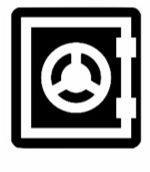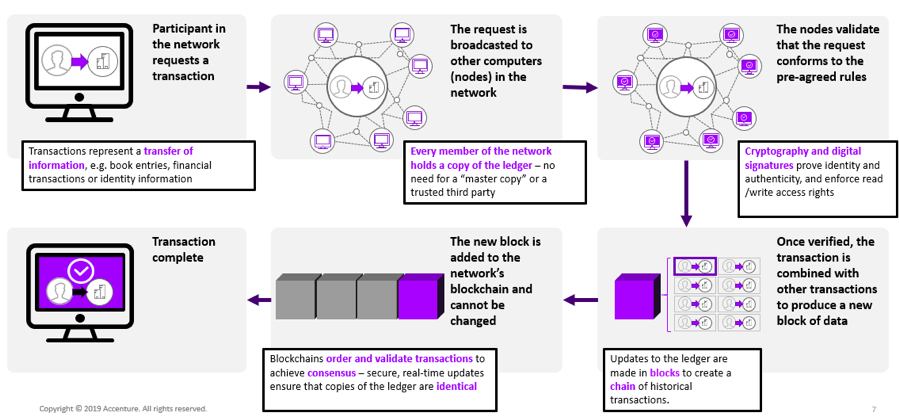Other parts of this series:
Mention the word “blockchain” in polite conversation and you may as well be speaking in Greek. With my new blog series on blockchain, I aim to demonstrate the value this relatively new piece of platform technology could have on the future of human resources and talent management in financial services.
But first, let’s demystify some of the terms we’ll be using over the next few weeks.
What is blockchain?
Blockchain is a multi-party system that maintains and records data in a way that allows multiple stakeholders to confidently and securely share access to the same data and information.
As Human Resources are continually exposed to and collecting sensitive data through external and internal process, the use of blockchain can provide peace of mind for both employees giving data and those collecting it. Features of blockchain that drive confidence between businesses participating in these multi-party ecosystems include:
- Provenance – Knowing where the data comes from, and the ability to trace the complete history—including who has ‘touched’ it.
- Tamper evidence – The mathematic ability to know if anyone has tampered with the data.
- Granular control – Each data element can be encrypted with identity and security features specific to control who can access what.
- Security – Each data element is encrypted and segregated.
For example, a traditional database is not unlike a password protected excel workbook—if hacked, every row and column is exposed. In a blockchain based system, every cell has been encrypted, which creates a smaller threat surface.
The infographic below shows how blockchain works in practice:
Blockchain 101—the basic building blocks
To better understand blockchain, we can explain its key features through basic concepts:
 1. Transparency and decentralization
1. Transparency and decentralization
Imagine a huge vault inside a bank. The vault is filled with rows of unlabeled deposit boxes with glass facades that allow everyone to see the contents, but not to access them. When you open a new deposit box, you receive a key that is unique to that box. Making a copy of the key does not duplicate the contents of the box. And even though you have the key, the box is not technically yours. You only have the ability to access what’s inside. The whole vault is the blockchain system—it allows people to store and transfer content from one deposit box to another, and shows how this is happening.
 2. Collaborative viewing and editing
2. Collaborative viewing and editing
Google Docs allows multiple users to view and edit a document at the same time. It reduces the amount of time you have to wait for the other party to receive, view, edit and send the document back. Normally, when using software like Microsoft Word, only one person can access and edit a document at a time, while everyone else is locked out. As with Google Docs, blockchain solves the issue by updating all changes for everyone to see in real time.
 3. Transaction recording and updating
3. Transaction recording and updating
Like DNA, which is a record of genetic transactions and mutations that spread as life expanded across the earth, blockchain too is a record of transactions, spreading across the internet as more people log transactions and become part of the network. Both become more complicated over time as our DNA evolves and new blocks are added to the blockchain. This complicated evolution via the updating of additional transactions continually makes the blockchain safer and more secure as it roots in an established string of data.
Now, let’s dive into some of the more complicated terms.
- API (application programming interface): a software intermediary that allows two applications to talk to each other.
- Business logic layer: a part of a program’s code that determines the rules to be followed when doing business.
- Consensus: when a majority of network participants agree on the validity of a transaction and add it to the ledger in an order agreed upon by all peers in the network.
- Cryptographic hash function: a function that returns a unique fixed-length string. The returned string is unique for every input. It is used to create a “digital ID” or “digital thumbprint” for an input string.
- Digital asset: a digital representation of any physical object that takes on characteristics of uniqueness, current and previous ownership, history of the asset and end of life of the asset. Not to be confused with digital asset holdings.
- Digital signature: a mathematical scheme used for presenting the authenticity and ownership of digital assets.
- Digital wallet: stores the digital assets you own.
- Immutability: when data stored in a blockchain is unable to be changed, not even by administrators. The only exception is when a majority of nodes agree to update the data in the ledger.
- Node: any computer that connects to a blockchain network and runs the blockchain protocol is called a node. “Full nodes” contain a complete record of the blocks, perform the validation of transactions, create new blocks, and facilitate messaging between the other nodes to form the distributed network. Nodes can also be processing or “partial” nodes, with limited or restricted permissions on the network.
- PKI (public key infrastructure): a set of roles, policies and procedures needed to create, manage, distribute, use, store and revoke digital certificates and manage public key encryption.
- Smart contract: a programmable contract which facilitates, verifies or enforces contract terms without third parties. These digital contracts are a new way to improve complex, multi-stakeholder transactions where changes must be verified by numerous parties across siloed systems.
- Token: representation of a digital asset built on an existing blockchain. In permissioned systems, spammers and abusers can be identified and banned from the system relatively easily, so tokens are not as necessary. In permissionless systems, tokens serve two main purposes:
- To provide an economic incentive for the protocol participants to form consensus in decentralized systems
- To prevent spam and denial of service attacks.
There you have it: blockchain demystified. In my next post, I’ll discuss how we can use blockchain to address HR pain points in financial services.
Contact me here or on Twitter @knott_nic or connect on LinkedIn with my colleagues Colin Strasburg and Oliver Grindrod to chat about blockchain, to find out more about digital HR in financial services or to join us at the Change Directors Forum and People Innovation Forum in London.












